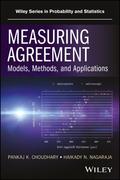Measuring Agreement
Models, Methods, and Applications
Wiley Series in Probability and Statistics

1. Edition January 2018
360 Pages, Hardcover
Wiley & Sons Ltd
Short Description
Focusing primarily on evaluation of agreement with continuous measurements with additional coverage devoted to categorical measurements, Measuring Agreement Methodology and Applications successfully blends the currently available statistical methodologies for agreement evaluation in a unified, coherent, and lucid manner. This up-to-date and comprehensive book describes the theoretical underpinnings of the methodologies and presents case studies using several real data sets to illustrate the application of the methodologies. A perfect reference for statisticians, biostatisticians, clinical chemists, and biomedical scientists.
Presents statistical methodologies for analyzing common types of data from method comparison experiments and illustrates their applications through detailed case studies
Measuring Agreement: Models, Methods, and Applications features statistical evaluation of agreement between two or more methods of measurement of a variable with a primary focus on continuous data. The authors view the analysis of method comparison data as a two-step procedure where an adequate model for the data is found, and then inferential techniques are applied for appropriate functions of parameters of the model. The presentation is accessible to a wide audience and provides the necessary technical details and references. In addition, the authors present chapter-length explorations of data from paired measurements designs, repeated measurements designs, and multiple methods; data with covariates; and heteroscedastic, longitudinal, and categorical data. The book also:
* Strikes a balance between theory and applications
* Presents parametric as well as nonparametric methodologies
* Provides a concise introduction to Cohen's kappa coefficient and other measures of agreement for binary and categorical data
* Discusses sample size determination for trials on measuring agreement
* Contains real-world case studies and exercises throughout
* Provides a supplemental website containing the related datasets and R code
Measuring Agreement: Models, Methods, and Applications is a resource for statisticians and biostatisticians engaged in data analysis, consultancy, and methodological research. It is a reference for clinical chemists, ecologists, and biomedical and other scientists who deal with development and validation of measurement methods. This book can also serve as a graduate-level text for students in statistics and biostatistics.
Chapter 1: Introduction
1.1 Preview
1.2 Notational conventions
1.3 Basic characteristics of a measurement method
1.4 Method comparison studies
1.5 Meaning of agreement
1.6 A measurement error model
1.7 Similarity versus agreement
1.8 A toy example
1.9 Controversies and our view
1.10 Concepts related to agreement
1.11 Role of confidence intervals and hypotheses testing
1.12 Common models for paired measurements data
1.13 The Bland Altman plot
1.14 Common regression approaches
1.15 Inappropriate use of common tests in method comparison studies
1.16 Key steps in the analysis of method comparison data
1.17 Chapter summary
1.18 Bibliographic note
Exercises
Chapter 2: Common Approaches for Measuring Agreement
2.1 Preview
2.2 Introduction
2.3 Mean squared deviation
2.4 Concordance correlation coefficient
2.5 A digression: Tolerance and prediction intervals
2.6 Lin's probability criterion and Bland Altman criterion
2.7 Limits of agreement
2.8 Total deviation index and coverage probability
2.9 Inference on agreement measures
2.10 Chapter summary
2.11 Bibliographic note
Exercises
Chapter 3: A General Approach for Modeling and Inference
3.1 Preview
3.2 Mixed effects models
3.3 A large-sample approach for inference
3.4 Modeling and analysis of method comparison data
3.5 Chapter summary
3.6 Bibliographic note
Exercises
Chapter 4: Paired Measurements Data
4.1 Preview
4.2 Modeling of data
4.3 Evaluation of similarity and agreement
4.4 Case studies
4.5 Chapter summary
4.6 Technical details
4.7 Bibliographic note
Exercises
Chapter 5: Repeated Measurements Data
5.1 Preview
5.2 Introduction
5.3 Displaying data
5.4 Modeling of data
5.5 Evaluation of similarity and agreement
5.6 Evaluation of repeatability
5.7 Case studies
5.8 Chapter summary
5.9 Technical details
5.10 Bibliographic note
Exercises
Chapter 6: Heteroscedastic Data
6.1 Preview
6.2 Introduction
6.3 Variance function models
6.4 Repeated measurements data
6.5 Paired measurements data
6.6 Chapter summary
6.7 Technical details
6.8 Bibliographic note
Exercises
Chapter 7: Data from Multiple Methods
7.1 Preview
7.2 Introduction
7.3 Displaying data
7.4 Example datasets
7.5 Modeling unreplicated data
7.6 Modeling repeated measurements data
7.7 Model fitting and evaluation
7.8 Evaluation of similarity and agreement
7.9 Evaluation of repeatability
7.10 Case studies
7.11 Chapter summary
7.12 Technical details
7.13 Bibliographic note
Exercises
Chapter 8: Data with Covariates
8.1 Preview
8.2 Introduction
8.3 Modeling of data
8.4 Evaluation of similarity, agreement and repeatability
8.5 Case study
8.6 Chapter summary
8.7 Technical details
8.8 Bibliographic note
Exercises
Chapter 9: Longitudinal Data
9.1 Preview
9.2 Introduction
9.3 Modeling of data
9.4 Evaluation of similarity and agreement
9.5 Case study
9.6 Chapter summary
9.7 Technical details
9.8 Bibliographic note
Exercises
Chapter 10: A Nonparametric Approach
10.1 Preview
10.2 Introduction
10.3 The statistical functional approach
10.4 Evaluation of similarity and agreement
10.5 Case studies
10.6 Chapter summary
10.7 Technical details
10.8 Bibliographic note
Exercises
Chapter 11: Sample Size Determination
11.1 Preview
11.2 Introduction
11.3 The sample size methodology
11.4 Case study
11.5 Chapter summary
11.6 Bibliographic note
Exercises
Chapter 12: Categorical Data
12.1 Preview
12.2 Introduction
12.3 Experimental setups and examples
12.4 Cohen's kappa coefficient for dichotomous data
12.5 Kappa type measures for more than two categories
12.6 Case studies
12.7 Models for exploring agreement
12.8 Discussion
12.9 Chapter summary
12.10 Bibliographic note
Exercises
References
Dataset List
Index
H. N. NAGARAJA, PhD, is Professor Emeritus at The Ohio State University where he has served in the Departments of Statistics and Internal Medicine and the Division of Biostatistics. He is a fellow of the American Statistical Association and the American Association for the Advancement of Science, and an elected member of the International Statistical Institute. His published works include Order Statistics, Third Edition (with H. A. David) and Records (with B. C. Arnold and N. Balakrishnan), both published by Wiley.


